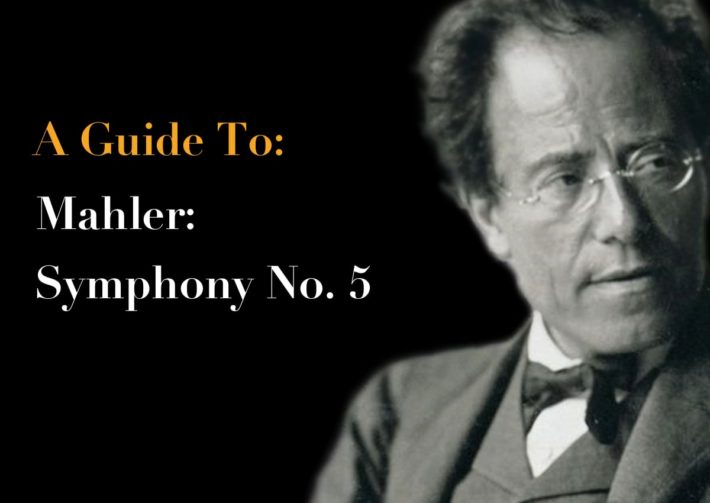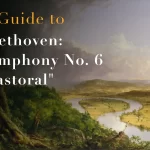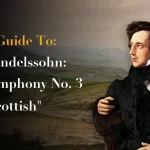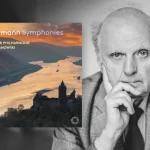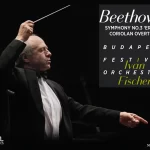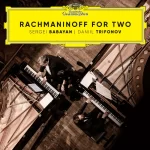Editor’s note: Timings on this guide are taken from Leonard Bernstein’s recording with the Vienna Philharmonic Orchestra (DG):
Gustav Mahler’s Symphony No. 5 is the first of three ‘middle period’ symphonies. Unlike the previous ‘Wunderhorn’ symphonies, the fifth has neither a program nor a sung text. Yet it does present a significant change in Mahler’s compositional style, including a heightened use of polyphony and a brilliant, more leonine orchestration.
In February 1901 Mahler nearly died from a major hemorrhage. During recuperation he studied the music of Bach, telling a friend, “In Bach, all the seeds of music are combined, as God encompasses the world. There has never been greater polyphony.” This enthusiasm found its way into the fifth symphony.
By the end of summer 1901, Mahler had sketched three of the work’s five movements. The last two movements were completed the following summer in Maiernigg (this time with his new wife Alma). The symphony’s orchestration was finished by October 1903.
After a 1904 read-through with the Vienna Philharmonic Orchestra, Mahler reduced the percussion, responding (at least in part) to Alma’s charge that he had composed a “percussion symphony.” Its premiere in Cologne on 18 October 1904 received a typically mixed reception. Mahler made further revisions after each subsequent performance, the final one made shortly before his death.
The symphony’s five movements are grouped into three parts: Part I (Movements 1 and 2); Part II (Movement 3); Part III (Movements 4 and 5). There is a significant amount of thematic interconnection between movements, as discussed below. The third movement acts as the symphony’s gravitational center.
Theodor Adorno described Mahler’s writing as an example of ‘variant technique’ – the presentation of material that is then reworked, modified, and transformed, thereby avoiding exact repetition. The short-short-short-long rhythm heard in the first movement’s initial fanfare (and in various figures throughout the movement) is surely a nod to Beethoven’s fifth, as is Mahler’s use of thematic interconnection between movements. Finally, both symphonies share the same emotional trajectory: the struggle from tormented darkness to brilliant light.
PART I
Movement 1: Trauermarsch. (Funeral march.)
A solo trumpet intones a fanfare, likely based on the Austro-Hungarian army’s “Generalmarsch.” The orchestra answers with a huge A-major chord, then quickly shifts to the minor, sputtering out figures based on the triplets heard in the trumpet’s fanfare (and echoing Beethoven’s motive from his fifth symphony). At 1’19”, first violins and cellos introduce an elegiac theme, accompanied by the bass line’s plodding march rhythm. The trumpet interjects with another fanfare, accompanied by horns, leading to a more richly harmonized version of the mournful theme. The trumpet again sounds it fanfare again, but before it can finish the orchestra rushes in (6’17”) with a wildly unhinged section (Trio 1). The trumpets play a chromatic melody in their high register, which is then taken over by the violins as the overall texture becomes ever more complex and chaotic. The music reaches a powerful climax (7’49”) that quickly dissipates; the trumpet sounds its fanfare, answered this time by three emphatic chords from the full orchestra. The elegiac music returns (8’55”) sounding even more like a military threnody when played by the winds. The two themes are then extended and varied until the fanfare motif is heard quietly on the timpani. Now in A minor (Trio 2), the music steadily builds in intensity, until a horn solo leads the entire orchestra into an anguished, primal cry (12’49”). The trumpet sounds the fanfare again, the strings muttering to themselves until they disappear. The fanfare is heard a final time, accompanied a grumbling bass drum. A sforzando snap from lower strings end the movement in complete desolation.
Movement 2: Stürmisch bewegt, mit grösster Vehemenz (Stormy, played with great vehemence)
As the tempo marking indicates, the opening is ferocious, woodwinds shrieking over the strings playing triple-forte, violins told to play “as vehement as possible!” The fury subsides, making room for a secondary melody played by cellos, a variation of the melodic material from the Trio 2 of the previous movement. The original tempo and mood return at 3’42”, subsiding soon after so the cellos can begin a fragile but heart-breaking lament (4’29”). This unexpected stillness is disturbed by horns at 5’46” who usher in extended development of the second trio material. At 7’55” the music adopts a more march-like character, increasingly frenzied until it reaches a recapitulation of the opening material (8’39”). Suddenly (11’58”) there is a break in this unrelenting darkness as trumpets introduce a chorale-like figure and the tonality shifts into D major. A joyful climax is reached at 12’41” but the moment is short-lived: the opening music returns to nullify all joy, a tam-tam stroke ending any sense of victory. A series of whispered mutterings from various instruments end the movement, the mood sullen and lifeless.
PART II
Movement 3: Scherzo (Kräftig, nicht zu schnell – Strongly, not too fast)
This was the first movement composed, and in a conversation with Natalie Bauer-Lechner, Mahler described it “kneaded through and through till not a grain of the mixture remains unmixed and unchanged. Every note is charged with life and the whole things whirls around in a giddy dance.” At 819 bars, it is Mahler’s longest scherzo. The opening horn fanfare uses the same three-note striving figure heard in the opening of previous movement, but the mood could not be more different. This dance music, moving between simple country ländlers to sophisticated city waltzes. The writing for the first horn even suggests elements of concerto (a feeling amplified more strongly if the performance follows Mengelberg’s practice of having the first horn stand in front of the orchestra).
The movement could be divided into six parts: an A section, in which the main (country dance) theme is introduced and varied until arrival at the first trio (2’43”), which only lasts 38 bars. The opening material returns at (3’50”), ending with a densely contrapuntal passage that leads directly into the second trio (5’09”), which brings a slower tempo and significant change in mood) This trio lasts over 200 bars, and features passages between the solo horn and the horn section that Deryck Cooke described as “horn echoing and re-echoing as if across mountain distances.”
A short development of the melodies from the first trio and main theme begins at 10’40”, leading into a compressed recapitulation at 11’53” where music from main section and both trios is subjected to further variation. The Coda begins quietly, but a sudden fortissimo brings progressively frenzied writing that concludes with two powerful chords.
PART III
Movement 4: Adagietto (Sehr Langsam – Very slowly)
This gorgeous ‘song without words’, with its simple ABA structure stands in stark contrast to the complexity heard in the other movements. Wilhelm Mengelberg said that Mahler sent this music to Alma as a declaration of love. She immediately understood and responded asking him to quickly come to her and they were engaged soon after. Mengelberg’s conducting score even has a love poem written over the first violin melody; whether the words originated with Mahler or Mengelberg is unclear.
Two passages strengthen the idea that this music is a love song for Alma. One is a quote of the “gaze motif” from Wagner’s “Tristan und Isolde” (a reference Alma surely would have recognized). More significant is the transfigured version of Mahler’s song “Ich bin die Welt abhanden” (I am alone in the world) heard at the end. Mahler quotes the portion setting “I live alone in my heaven, in my love, in my song.” In the song this moment is forlorn and delicate, but here it is richly harmonized, played with a fulsome power, as if Mahler is saying to his new bride “I am no longer alone, because now, I have you.”
Movement 5: Rondo – Finale (Allegro – Fast)
The solo horn calls us to attention, answered by the bassoon, which quotes another song, “Lob des hohen Verstandes,” which described a song contest between a nightingale and a cuckoo, judged by a donkey. (Perhaps this is a sarcastic reference to Mahler’s critics?) The various instruments calling to one another suggests the nature music heard in the composer’s first symphony – but it also presents the thematic materials from which Mahler will build this movement.
A fugal passage beings at 1’22”, cellos presenting the subject, which then migrates to the second violins, accompanied by a countersubject in the lower strings that is a sped-up version of the victorious chorale theme heard at the end of second movement. The fugue is rudely interrupted by two brass ‘raspberries’ (2’23 and 2’37”), after which the rondo theme is presented with a simpler homophonic texture (2’53”). A new fugal passage begins at 3’30” and a new subject soon appears, a sped-up version of the Adagietto theme, playful and flirty.
The Development (while Mahler labels the movement a Rondo, it is really a blending of Rondo and Sonata form) begins at 5’08 with another, more lightly scored, fugal passage. The music travels through various keys and registers, the melodic material constantly varied, eventually leading to another appearance of the Adagietto theme, this time in dialogue with a playful horn solo. Yet another fugal passage begins (8’14”), reaching the movement’s biggest climax thus far (9’12”) and signaling arrival at the Recapitulation.
After another reworking of the melodic material, a 33-bar pedal point on G (10’34”) suggests the music is building heading towards a significant climax, but once that moment is reached the music quickly peters out. Mahler then revisits each of the themes, finally settling on the Adagietto love theme (perhaps to take a final glance at Alma before making his final ascent). At 12’59” the music begins propelling itself forward with a will, finally reaching the long sought after climax of the chorale theme at 13’51”. Having finally achieved the music’s emotional goal (and much like his beloved Beethoven), the coda continues the celebration of the chorale theme’s victory, Mahler, perhaps for the first and only time, believing that everything is right with the world.
Essential Recordings
Vienna Philharmonic Orchestra & Leonard Bernstein, conductor; DG 4776334
The Viennese is on superb form, the chemistry between orchestra and conductor particularly palpable. Bernstein’s interpretation is slower than his earlier recording with the New York Philharmonic and his interpretive points at times lack subtlety. Nevertheless, there is an intensity to this reading that sweeps all before it. Bernstein convinces the Vienna Philharmonic to play with a ferocity that at times crosses into harsh ugliness, which makes the victorious coda more emotionally convincing and thrilling.
Berliner Philharmoniker & Claudio Abbado, conductor; DG 4793204 (Symphonies 1-9)
Abbado’s reading has fire and finesse, brilliance and precision, in equal measure. He also has the full measure of the music’s emotional trajectory, bringing us from the dark pessimism of the funeral march to the final movement’s joyful elation. The Berliners offer stunning technical security, the brass in particular covering themselves in glory.
Vienna Philharmonic Orchestra, Boulez (DG)
Boulez’s Mahler performances are admired by some, reviled in others. His reading of the fifth is not a hyper-emotional (for that, turn to Bernstein and Barshai). But the Viennese orchestra plays with perhaps even greater virtuosity here than in Bernstein’s earlier recording, and Boulez ensures we hear every strand of Mahler’s score, allowing us to appreciate the full brilliance of Mahler’s writing. And despite a slower than expected tempo, the Adagietto’s understated delicateness is deeply touching. The box set is an incredible value, containing almost everything in the composer’s oeuvre.
Junge Deutsche Philharmonie & Rudolph Barshai
This orchestra of high school students may seem out of place in this exalted list of the world’s finest orchestras, but their one-off live recording may well be one of the best overall performance of the symphony. The playing has tremendous power and weight, but more importantly these musicians play as if their life depends on it. Barshai’s interpretation is emotionally searing; used copies of the CDs are exorbitantly over-priced, but one can download a recording for less than $10 – this is a must have!
Gewandhaus Orchester & Riccardo Chailly, conductor; Accentus 10284
Chailly’s 1990s audio recording with the Royal Concertgebouw Orchestra (Decca) was well-received and features phenomenal sound, but the interpretation leaves me cold. This 2013 live video recording was part of a Gewandhaus Mahler Festival and is far more emotionally intense. Interestingly, every movement is faster (the Adagietto significantly so) than his previous Amsterdam reading. There is also a bonus feature in which Chailly discusses his interpretation of the work, a fascinating description of both the symphony and his evolving interpretation.
Finally, two out-of-print recordings well worth finding:
Philharmonia Orchestra & Benjamin Zander, conductor; Telarc 80569
Zander’s reading is direct and meticulously prepared. His approach is more objective than Bernstein and Tennstedt; nevertheless, it is emotionally satisfying. The Philharmonia play very well, if not in the same league as the three recordings listed above. The symphony’s recording is made more valuable by the companion disc, a 70-plus minute lecture about the music and its interpretation.
Royal Liverpool Philharmonic Orchestra & Charles Mackerras, conductor; EMI Eminence 2164
Mackerras was not known as Mahler conductor, nor is the Liverpool orchestra in the same league as their Berlin, Vienna and Amsterdam colleagues. EMI’s recording is clear but lacks atmosphere. Nevertheless, Mackerras inspires a fully committed reading that has an impressive dramatic arch. The Scherzo is a particular highlight, and the arrival of the chorale at the end of the final movement feels like a genuine catharsis.

Support Us
We hope this guide has helped you navigate the wonderful world of classical music! If you enjoyed this free resource, consider making a donation to The Classic Review. Your generosity helps us keep the music playing by allowing us to publish informative guides, and insightful reviews. Every contribution, big or small, allows us to continue sharing our passion for classical music with readers like you.
Donate Here
Albums are included with an Apple Music subscription:
Latest Classical Music Posts
- Review: Schumann – Complete Symphonies – Dresdner Philharmonie, Janowski
- Review: Mozart – The Sonata Project, Salzburg – Yundi, Piano
- Review: Beethoven – Symphony No. 3 (“Eroica”) – Budapest Festival Orchestra – Iván Fischer
- Conductor Edo de Waart Announces Retirement
- Review: Pergolesi – Stabat Mater, Vivaldi: Nisi Dominus – Patchornik, Engeltjes, PRJCT Amsterdam
- Review: Rachmaninoff for Two – Daniil Trifonov, Sergei Babayan
Follow Us and Comment:
Get our periodic classical music newsletter with our recent reviews, news and beginners guides.
We respect your privacy.

